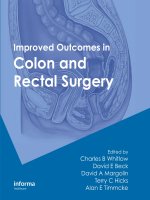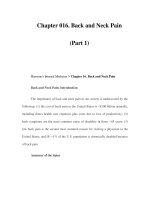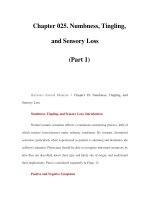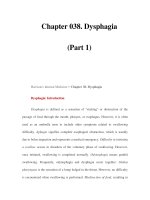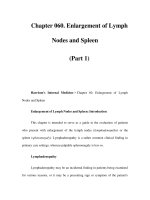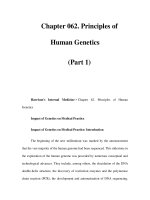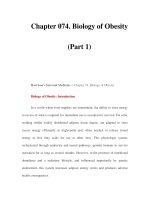Neurology 4 mrcp questions book - part 1 ppsx
Bạn đang xem bản rút gọn của tài liệu. Xem và tải ngay bản đầy đủ của tài liệu tại đây (203.85 KB, 14 trang )
Question Book / Contents:
A total of 17 chapters containing 713 questions
distributed as;
1- Cardiology; 55 questions.
2- Pulmonary medicine; 51 questions.
3- Gastro-enterology; 50 questions.
4- Hepato-biliary system; 30 questions.
5- Nephrology; 51 questions.
6- Electrolytes and Acid-Base Disturbances; 20
questions.
7- Endocrinology; 50 questions.
8- Diabetes Mellitus; 20 questions.
9- Hematology; 40 questions.
10- Rheumatology; 50 questions.
11- Neurology; 176 questions.
12- Infectious diseases; 40 questions.
13- Immunology; 10 Questions.
14- Psychiatry 10 questions.
15- Dermatology; 35 questions.
16- Genetics; 5 questions.
17- Toxicology; 20 questions.
NB: Questions regarding basic medical sciences are
distributed throughout chapters.
This is the Question Book
Please see answers in the Answers Book
Preface:
The art of medicine involves questions. It involves
questions asked when taking a medical history, when
forming a differential diagnosis, and when planning a
diagnostic or therapeutic plan. MRCP candidates,
regardless of their level of training, are constantly
confronted with questions posed from past papers, from
patients, from mentors, and from within themselves.
The time-honored, question-based, Socratic approach
of teaching is alive and well in academic and clinical
world of internal medicine. This book is intended to
provide the reader with many of the questions and
answers commonly encountered during their MRCP
study and period of preparation. This book is not meant
to replace textbooks. Rather it intended to focus on the
lead-in questions and topics commonly seen in the
MRCP examination. Please read textbooks to boost
your level of knowledge. Some of the 1
st
chapters were
launched in www.aippg.net
website; but these are now
modified and updated.
I'm greatly thankful to my direct board supervisor
Professor Doctor Khalil Al-Shaikhly (MRCP UK,
FRCP Glasgow) for his continuous support, to our dear
patients, and to my dear friends and colleagues.
Dr. Osama Amin
All Rights Reserved. January 2006.
/> />
Chapter I / Cardiology
Q1: The followings are causes of a prominent R wave in Lead V1, EXCEPT:
a- Posterior wall myocardial infarction.
b- Right bundle branch block.
c- Mirror image dextrocardia.
d- Wolf-Parkinson-White Syndrome type A.
e- Wolf-Parkinson-White Syndrome type B.
Q2: Which one of the followings is associated with ST segment elevation in ECG
recordings?
a- Left ventricular hypertrophy.
b- Right ventricular hypertrophy.
c- Digoxin effect.
d- Early repolarization after an attack of angina.
e- Subendocardial infarction.
Q3: The commonest type of Arrhythmia in WPW syndrome is?
a- Vnetricular tachycardia.
b- Ventricular fibrillation.
c- Ventricualr premature complexes.
d- Atrial ectopics.
e- AV nodal re-entry tachycardia.
Q4: The following cardiac lesions are seen in Noonan's syndrome, except:
a- Mental retardation.
b- Pulmonary artery stenosis.
c- Branch pulmonary artery stenosis.
d- Hypertrophic obstructive cardiomyopathy.
e- Mitral stenosis.
Q5: Causes of long QT Syndrome include all of the followings, except:
a- Hypokalaemia.
b- Hypocalcaemia.
c- Hypomagnesaemia.
d- Hypermagnesaemia.
e- Rheumatic carditis.
Q6: In Hypertrophic cardiomyopathy, which one is true?
a- Caused by a mutation in sodium channels.
b- 25% of cases are associated with a positive family history.
c- 30% of cases are associated with left ventricular outflow obstruction.
d- All patients are symptomatic.
e- The commonest type of hypertrophy in the western world is the apical one.
Q7: Acute pericarditis, which one is the false statement?
a-The commonest cause is the idiopathic form which may be viral.
b- The majority of cases would progress to pericardial tamponade.
c- In uraemic pericarditis, there is a risk of pericardial tamponade formation.
d- The rub is usually transient.
e- TB pericarditis is rarely presented as an acute process.
Q8: Which one of the following indicates an absolute contraindication to
thrombolytic therapy in acute ST segment elevation myocardial infarction,
a- A 70year old hypertensive male with acute chest pain and new diastolic murmur in
the left lower sternum and ST elevation in lead II,III and aVF .
b- A 40 year old lady with 7 missed periods and progressive abdominal distension.
c- A 34 old diabetic male recently underwent "LASER retinal therapy", came with
chest pain, shock, raised JVP and clear lungs.
d- ST segment elevation in lead V1, V2, and V3 with a blood pressure of 180/100
which is then easily controlled with antihypertensive medications
e- A 60 year old male who is a known case of ischemic heart disease presents with
new left bunble branch block and chest pain for 2 hours with ST segment elevation in
V4, V5, and V6.
Q9: All of the following cadiovascular medications have a veno-dilating effect,
except one:
a- Hydralazine.
b- Lisinopril.
c- Prostacycline.
d- Isosorbide dinatrate.
e- Prazosin.
Q10: High risk factors in unstable angina include all of the followings, except:
a- Development of heart failure.
b- Prolonged chest pain.
c- ST segment elevation.
d- High cardiac troponin T.
e- Normal ECG.
Q11: The followings are true, except:
a- The right coronary artery supplies the AV node in 90 % of cases.
b- The right coronary artery supplies the SA nose in 60 % of cases.
c- The left main stem coronary artery is easily dilated by at PTCA in atheromatous
narrowing and should be routinely done in such cases.
d- Prinzmetal's angina usually occurs at night.
e- Prinzmetal's angina may occur with or without coronary atheromas.
Q12: Amiodarone, all are true, except:
a- 40% of its formulation is iodine.
b- Potentiates the effect of warfarine.
c- Potentiates the effect of digoxin.
d- Corneal deposits of the drug are usually irreversible.
e- Prolonges the plateau phase of action potential.
Q13: Causes of raised JVP include all of the followings, except:
a- Mediastinal lymphoma.
b- Mediastinal irradiation 2 years previously.
c- ST segment elevation in lead rV4 and retrosternal chest pain.
d- Liver cirrhosis
e- Atrialization of the right ventricle.
Q14: Coarctation of the aorta, which one of the followings is the false statement?
a- In adults, usually causes and presents as hypertension.
b- Bicuspid aortic valve is a common association.
c- Rib notching is usually seen from the 3
rd
rib till 9
th
rib in infancy.
d- Aortic dissection is a recognized complication.
e- Subarachnoid hemorrhage may occur.
Q15: The followings improve survival figure in chronic congestive heart failure
as shown by many studies, except:
a- Bisprolol.
b- Metaprolol.
c- Carvidolol.
d- Spironolactone.
e- Atenolol.
Q16: Infective endocarditis which one is the false statement?
a- Streptococcus viridans is the cause of up to 50% of native valve endocarditis.
b- Staph species may be the cause in 50% of prosthetic valve endocarditis.
c- The commonest cause of culture negative endocarditis is partial treatment with
antibiotics.
d- 3 negative serial blood cultures usually exclude infective endocarditis in the
appropriate clinical setting.
e- The sensitivity of transesophageal echocardiography for the detection of
vegetations is 95% versus 65% in the transthoracic approach.
Q17:The following cardiac lesions are associated with a high risk of infective
endocarditis, except:
a- Ventricular septal defect.
b- Hypertrophic cardiomyopathy.
c- Combined mitral valve disease.
d- Mitral valve prolapse with significant mitral regurgitation by echo study.
e- Lone mitral stenosis.
Q18: Treatment of infective endocarditis, all are true, except:
a- Persistent fever despite appropriate antibacterial antibiotic regimen may indicate a
non bacterial cause like fugal cause.
b- Cidal drugs rather than statics should be used.
c- Always await the culture results before giving any treatment.
d- Intravenous route is always preferred.
e- Persistent fever may simply indicate a drug fever.
Q19: Lone mitral stenosis, all are true, except:
a- A malar flush may be seen, which may be confused with that of SLE.
b- There is a low cardiac output state which may contribute to the poor exercise
tolerance.
c- Rarely congenital in origin.
d-A third heart sound is commonly detected.
e- 20% of cases stays in sinus rhythm despite severe stenosis.
Q20: Aortic stenosis, all are true, except:
a- Carotid shudder is common.
b- Syncope indicates an urgent need for intervention.
c- It is sub-valvular in William's Syndrome.
d- Marked left ventricular hypertrophy per se is a risk factor for angina and
arrhythmias.
e- Valve replacement is the usual mode of treatment.
Q21: Objectives in medical treatment of heart failure, all are true, except:
a- Reduction of the after load.
b- Optimization of the preload.
c- Augmentation of the cardiac contractility.
d- Controlling the heart rate.
e- Aggressive diuresis to remove all edemas.
Q22: Diastolic heart failure, which one of followings is true?
a- Aortic regurgitation usually causes diastolic dysfunction.
b- Till now there is no general consensus about the optimal medical management for
it.
c- Myocardial ischemia starts with systolic dysfunction.
d- Tachycardia is needed to compensate for the defect and hence the heart rate should
be kept below 100 beats/minutes.
e- ACE inhibitors had been shown to improve the mortality figure.
Q23: Secondary hypertension can be suspected by the presence of all of the
followings, except:
a- A Rapid development.
b- A poor response to standard medical therapy.
c- An age blow 20 years or above 50 years.
d- Mooning of the face and abdominal striae.
e- Strong family history of hypertension.
Q24: Long standing hypertension, choose the truest statement?
a-Has a very weak effect on the coronary arteries.
b-A strong risk factor for the development of intracerebral hemorrhage.
c- In diabetic nephropathy the target blood pressure should be ideally below 140 /
90mmHg.
d- ACE inhibitors should be routinely prescribed.
e-Diuretics are usually not effective in elderly.
Q25: Possible Risk factors for ischemic heart disease, which one is the false
statement?
a-Hyperhomocystenemia.
b-Obesity.
c-Sedentary life style.
d-High blood fibrinogen.
e-Diet rich in vegetables .
Q26: Complications of long standing hypertension include all of the followings,
except:
a- Diastolic heart failure.
b- Coronary artery disease.
c- Stroke.
d- Peripheral vascular disease.
e- Systolic heart failure.
Q27: Atrial myxoma, which one is the false statement?
a- May present as an infective endocarditis-like picture.
b- May present as a vasculitis-like picture.
c- High risk of local recurrence following surgery in sporadic cases.
d- High risk of local recurrence following surgery in familial cases.
e- When arises from the right side of the heart we should think of familial
predisposition.
Q28: All of the following beta blockers are considered to be "non-cardio
selective",except:
a- Metoprolol.
b- Nadalol.
c- Propranolol.
d- Pindolol.
e- Timolol.
Q29: When examining the JVP, which one is the wrong statement?
a- A rapid x descent and steep y descent occurs in pericardial constriction.
b- A rapid x descent and blunted y descent occurs in pericardial tamopnade.
c- A large V wave occurs in tricuspid regurgitation.
d- Hepatojugular reflux is important only if it sustains upon continuous pressure on
the abdomen.
e- Regular cannon "a" waves indicate complete heart block.
Q30: Short PR interval occurs in:
a- Bradycardia states.
b- Treatment with propranolol.
c- Ischemic heart disease.
d- Treatment with theophyllin.
e- Hypothyroidism.
Q31: Deep Permanent Q wave may be seen in, choose one statement?
a- Hyperacute phase of an acute anterior wall myocardial infarction (MI).
b- WPW syndrome.
c- Established subendocardial infarction.
d- Established acute phase of an isolated posterior wall myocardial infarction.
e- During Prinzmetal's angina.
Q32: Coarctation of the aorta has many common associated lesions; all of the
followings are commonly associated with coarctation, except:
a- Ebstein anomaly.
b- Bicuspid aortic valve.
c- Patent ductus arteriosus.
d- Ventricular septal defect.
e- Berry aneurysm at the circle of Willis.
Q33: In the medical treatment of acute myocardial infarction, the followings are
true, except:
a- Aspirin per se reduces the mortality figure by 30%.
b- Thrombolysis reduces the mortality figure by 25-50%.
c- Beta blockers like iv metoprolol greatly reduces the susceptibility to arrhythmias.
d- iv nitroglycerin has no effect on the overall mortality figure.
e- Morphine better to be given by a subcutaneous route rather than iv because this
confers a longer half life.
Q34: Secondary prophylaxis of myocardial infarction (MI), which one is the false
statement?
a- ACE inhibitors have a favorable effect by many independent mechanisms.
b- Bata blockers are important if no contraindication is present to its use.
c- Statins had been shown to produce regression of the atherosclerotic plaques.
d- Cardiac rehabilitation programs should not be forgotten.
e- Digoxin had been shown to have a favorable effect.
Q35: Contraindication to exercise ECG testing in a patient with a suspected
ischemic heart disease, all of the followings are true, except:
a- Uncontrolled severe hypertension.
b- Fever or a febrile illness.
c- Severe aortic stenosis.
d- Acute pericarditis.
e- Subjective feeling of weakness.
Q36: The followings indicate a strong positive exercise ECG testing, .except:
a- Deep ST segment depression.
b- Wide spread ECG changes upon exercise.
c- Prolonged ST segment depression after finishing the test.
d- ST segment elevation per se.
e- Mild –moderate ST-T segment abnormalities in middle aged woman with chest
pain with no risk factors for ischemic heart disease.
Q37: False positive exercise ECG testing are common in clinical practice, causes
include all of the followings, except:
a- Prior treatment with digoxin.
b- History of hypertrophic cardiomyopathy.
c- Marked left ventricular hypertrophy.
d- Early development of wide spread ECG changes in stage I Bruce protocol
e- Presence of mitral valve prolapse.
Q38: During cardiac arrest of your patient who is recovering from acute
myocardial infarction in the CCU and who has no pulse You jumped to use DC
shock cardioversion but the nurse shouted that the monitor is showing a heart
rate of 90 beats per minutes, all of the followings can cause this complication,
except:
a- Pulmonary thromboembolism.
b- Tension pneumothorax.
c- Profound shock due to bleeding.
d- Hypokalemia.
e- Treatment with xylocain.
Q39: Use of ACE inhibitors in the medical treatment of Post- myocardial
infarction (MI) patients, all of the followings are true, except:
a- Had been shown to decrease ventricular remodeling and hence aneurysmal
formation.
b- Prevent the onset of overt heart failure in asymptomatic patients.
c- Reduce the hospitalization rate.
d- Should be given to all patients if tolerated and with no contraindications.
e- Contraindicated in post MI patient with an established chronic renal failure
Q40: Treatment of hypertension with diuretics, all are true, except:
a- Loop diuretics are preferred because of their powerful effect.
b- Diuretics in the treatment of hypertension uncommonly produce acid base and
electrolyte disturbances.
c- As an anti- hypertensive medication, they work by an independent mechanism of
their diuretic action.
d- They are the first line agents in an elderly with systolic hypertension.
e- They may worsen the lipid profile.
Q41: Primary pulmonary hypertension, all of the followings are true, except:
a- An association with HIV infection has been seen.
b- Medial hypertrophy and fibrinoid necrosis are seen in all branches of the
pulmonary arterial tree.
c- Physical signs are usually unimpressive until right sided heart failure sets in.
d- 5 out of every ten cases are familial.
e- Most patients die within 2-3 years of diagnosis.
Q42: Cor pulmonale, all of the followings are true, except:
a- May be acute or chronic.
b- The first physical sign is usually a raised JVP.
c- May be caused by post-polio syndrome.
d- The usual end result of many chronic debilitating lung diseases.
e- Is defined as right sided heart failure.
Q43: You have been asked to examine this 70 year old gentleman with COPD
who presents with excessive day time somnolence with poor concentration. You
noticed that his lips are a little bit dark in color. You will then examine which
one of the followings:
a- The chest for any new changes.
b- Retinal fundoscope
c- Trying to count the respiratory rate for hypoventilation.
d- His heart for any heart failure.
e- His neck for any swelling.
Q44: Pulmonary thromboembolisom, all of the followings are true, except:
a- Has diverse clinical manifestations ranging from totally asymptomatic to sudden
death.
b- Bed-side echocardiography is a useful and rapid tool in cases of acute massive
pulmonary theromboembolism.
c- Symptomatic pulmonary thromboembolism occurs up to 1% of all post operative
patients.
d- Autopsy incidence of post operative thromboembolism is 10-25%.
e- Up to 15% of all pulmonary thromboemboli came from the leg veins
Q45: Chest x ray findings in pulmonary thromboembolism, all of the followings
are true, except:
a- May be totally normal.
b- Subtle changes may be present like regional oligmemia.
c- Peripheral wedge shaped opacities are commonly seen.
d- Elevation of the diaphragm is a well recognized sign.
e- Abscess formation has been documented.
Q46: ECG changes in acute pulmonary thromboembolism, all of the
followingsare true, except:
a- Sinus tachycardia.
b- New right bundle branch block.
c- Acute atrial fibrillation may be seen.
d- S1 Q3 T3 pattern is very common.
e- T inversion over the right chest leads.
Q47: Treatment of acute pulmonary thromboembolism, all of the followings are
true, except:
a- Emergency embolectomy is rarely needed.
b- Thrombolytics should be used in massive pulmonary thromboembolism proved by
CT or angiography.
c- Heparin therapy per se has been shown to decrease mediator induced pulmonary
vasoconstriction.
d- Heparin therapy has not been shown to reduce the overall mortality in pulmonary
thromboembolism.
e- Oral anticoagulants have no place in the management of life threatening
thromboembolic disease.
Q48: General measures in acute pulmonary thromboembolic events, all of the
followings are true, except:
a- Opiates may be necessary to relieve pain and distress.
b- The use of inotropic agents is of great value in massive events.
c- Diuretics and vasodilators should be avoided at all times.
d- O2 should be given to all hypoxemic patients.
e- Resuscitation by external cardiac massage may be successful in moribund patients
by dislodging and breaking up a large central embolus.
Q49: Congenital heart disease, all are true regarding the incidence of various
types, except:
a- VSD -about 30 %
b- Atrial septal defects -10%
c- Patent ductus arteriosus -10%
d- Tetralogy of Fallot -16 %
e- Coarctation of aorta -7%
Q50: Congenital heart diseases, all of the followings are true, except:
a- Aortic regurgitation may occur in VSD. due to loss of support of the right coronary
cusp.
b- Fallot tetralogy patients are protected from Eisenmenger's syndrome because of the
pulmonic steosis.
c- ASD primum usually presents in infancy with arrhythmias.
d- Preventing the closure a Patent Ductus arteriosus with certain medications is useful
in certain congenital heart diseases. like tricuspid atresia
e- Transpositon of great vessels is the commonest cause of "cardiac cyanosis at birth".
Q51: Congenital heart diseases may have certain associations, all of the
followings are true, except:
a- ASD-triphalyngeal thumb.
b- Infant of a psychiatric mother –Epstein anomaly.
c- Maternal rubella- infant PDA.
d- Epileptic mother- interrupted aortic arch in the neonate.
e- Noonan's syndrome and mitral stensois.
Q52: In Aortic Regurgitation, the following clues are important in the
etiology of the regurgitation, all are true, except:
a- Bilateral small irregular pupils.
b- Long standing back pain with upper lobes fibrosis.
c- Both cubital fossae examination may be of great help.
d- Hand examination can give no extra information.
e- Slit lamp examination is useful in certain cases.
Q53: Mitral stenosis, all of the followings are true, except:
a- Giant V waves may be seen.
b- Pulmonary edema in pregnancy is an indication for emergency valvotomy.
c- Trans-mitral diastolic gradient of more than 15 mmHg indicates mild-moderate
degree of stenosis.
d- An episode of pulmonary edema without a precipitating cause is an indication for
surgery what ever the severity of stenosis was.
e- Although secondary pulmonary hypertension is common, yet Graham Steel
murmur is rare.
Q54: ECG findings in uncomplicated congenital heart disease, all of the
followings are true, except:
a- ASD secondum-partial right bundle branch block.
b- ASD primum –left axis deviation.
c- VSD-biventricular hypertrophy.
d- Ebstein anomaly-left ventricular hypertrophy.
e- Coarcatation of aorta –left ventricular hypertrophy.
Q55: Chest X ray findings in congenital heart disease, which one is the true
statement?
a- Rarely abnormal in long standing cases.
b- Boot shaped heart usually suggestive of ASD.
c- The sign of 3 is seen in aortic coarctation.
d- Large prominent hili are seen in Eisenmenger 's syndrome.
e- The patent ductus arteriosus is seen on the plain PA film.
END of Chapter I
Written By Dr. Osama Amin
All Rights Reserved
Chapter II / Pulmonary Medicine
Q1: The lungs, all are true, except:
a- The right lung has 10 segments.
b- Tthe left lung has 9 segments.
c- Tthe visceral pleura is exteremly sensitive to pain.
d- Tthe parietal pleura is extremely sensitive to pain.
e- Tthe left upper lobe has 4 segments.
Q2: Causes of hypercapnia include all of the followings, except:
a- Myasthenia gravis.
b- Central sleep apnea.
c- Ankylosing spondylitis.
d- Motor neuron disease.
e- Acute uncomplicated pneumonia.
Q3: Hypoxemia that is corrected with O2 therapy includes all of the followings,
except:
a- Large pulmonary arterio-venous malformation.
b- Acute pneumonia.
c- Pulmonary hemorrhage.
d- Pulmonary thromboembolism
e- Acute asthma.
Q4: Regarding lung imaging, which is the true statement?
a- MRI is usually used for parenchymal lesions.
b- High resolution CT scan is less helpful in interstitial diseases.
c- V/Q scan is contraindicated in ASD.
d- Bronchoscopy is useful in peripheral lung tumors.
e- Ultrasound examination of the chest is insensitive for the small detection of pleural
effusions.
Q5: Causes of low TLCO with normal or increased KCO includes all of the
followings, except:
a- Right sided pneumonectomy.
b- Severe ankylosing spondylitis.
c- Myasthenia gravis.
d- Poliomyelitis.
e- Fibrosing alveolitis.
Q6: Long term domiciliary oxygen therapy in COPD, all of the followings are
true, except:
a- Has been shown to decrease the mortality figure in selected patients with severe
COPD.
b- Used for at least 15 hours / day at a rate of 2-4 liters / minute.
c- The objective is to produce a PaO2 of more than 8 kPa without unacceptable rise in
PaCo2.
d- The patient should stop smoking before hand.
